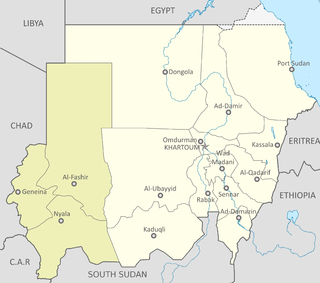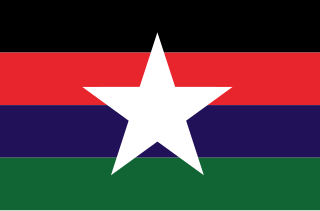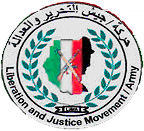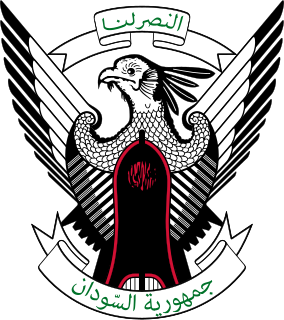
Omar Hassan Ahmad al-Bashir is a Sudanese former military officer and politician who served as the seventh head of state of Sudan under various titles from 1989 until 2019, when he was deposed in a coup d'état. He was subsequently incarcerated, tried and convicted on multiple corruption charges. He came to power in 1989 when, as a brigadier general in the Sudanese Army, he led a group of officers in a military coup that ousted the democratically elected government of prime minister Sadiq al-Mahdi after it began negotiations with rebels in the south. He was elected three times as president in elections that have been under scrutiny for electoral fraud. In 1992, al-Bashir founded the National Congress Party, which remained the dominant political party in the country until 2019. In March 2009, al-Bashir became the first sitting head of state to be indicted by the International Criminal Court (ICC), for allegedly directing a campaign of mass killing, rape, and pillage against civilians in Darfur. On 11 February 2020, the Sudanese government announced that it had agreed to hand over al-Bashir to the ICC for trial.

Darfur is a region of western Sudan. Dār is an Arabic word meaning "home [of]" – the region was named Dardaju while ruled by the Daju, who migrated from Meroë c. 350 AD, and it was renamed Dartunjur when the Tunjur ruled the area. Darfur was an independent sultanate for several hundred years until it was incorporated into Sudan by Anglo-Egyptian forces in 1916. As an administrative region, Darfur is divided into five federal states: Central Darfur, East Darfur, North Darfur, South Darfur and West Darfur. Because of the War in Darfur between Sudanese government forces and the indigenous population, the region has been in a state of humanitarian emergency and genocide since 2003. The factors include religious and ethnic rivalry, and the rivalry between farmers and herders.

The Justice and Equality Movement is an opposition group in Sudan founded by Khalil Ibrahim. Gibril Ibrahim has led the group since January 2012 after the death of Khalil, his brother, in December 2011. JEM's political agenda includes issues such as: radical and comprehensive constitutional reform to grant Sudan's regions a greater share of power in ruling the country, the replacement of social injustice and political tyranny with justice and equality, and basic services for every Sudanese.

The Sudan Liberation Movement/Army is a Sudanese rebel group active in Darfur, Sudan. It was founded as the Darfur Liberation Front by members of three indigenous ethnic groups in Darfur: the Fur, the Zaghawa, and the Masalit, among whom were the leaders Abdul Wahid al Nur of the Fur and Minni Minnawi of the Zaghawa.

The Eastern Front is a coalition of rebel groups operating in eastern Sudan along the border with Eritrea, particularly the states of Red Sea and Kassala. The Eastern Front's Chairman is Musa Mohamed Ahmed. While the Sudan People's Liberation Army (SPLA) was the primary member of the Eastern Front, the SPLA was obliged to leave by the January 2005 Comprehensive Peace Agreement that ended the Second Sudanese Civil War. Their place was taken in February 2004 after the merger of the larger Beja Congress with the smaller Rashaida Free Lions, two tribal based groups of the Beja and Rashaida people, respectively. The Justice and Equality Movement (JEM), a rebel group from Darfur in the west, then joined.

This article covers the period of the history of Sudan between 1985 and 2019 when then Sudanese Defense Minister Abdel Rahman Swar al-Dahab seized power from Sudanese President Jaafar Nimeiry in the 1985 Sudanese coup d'état. Not long after, Field Marshal Omar al-Bashir, backed by an Islamist political party, the National Islamic Front, overthrew the short lived government in a coup in 1989 where he ruled as President until his fall in April 2019. During Bashir's rule, also referred to as Bashirist Sudan, he was re-elected three times while overseeing the independence of South Sudan in 2011. His regime was criticized for human rights abuses, atrocities and genocide in Darfur and allegations of harboring and supporting terrorist groups in the region while being subjected to United Nations sanctions beginning in 1995, resulting in Sudan's isolation as an international pariah.

The War in Darfur, also nicknamed the Land Cruiser War, is a major armed conflict in the Darfur region of Sudan that began in February 2003 when the Sudan Liberation Movement (SLM) and the Justice and Equality Movement (JEM) rebel groups began fighting against the government of Sudan, which they accused of oppressing Darfur's non-Arab population. The government responded to attacks by carrying out a campaign of ethnic cleansing against Darfur's non-Arabs. This resulted in the death of hundreds of thousands of civilians and the indictment of Sudan's president, Omar al-Bashir, for genocide, war crimes, and crimes against humanity by the International Criminal Court.

Suliman Arcua Minnawi, known as "Minni Minnawi", is a Sudanese politician who was the leader of the largest faction of the Sudanese Liberation Army. A former educator, Minnawi was the Secretary of Sudan Liberation Army leader, Abdul Wahid Nur, before the organisation split in 2004. Minnawi belongs to the Zaghawa ethnic group, the Ila Digen clan of the non-Arab, Saharan Zaghawa people.

While there is a consensus in the international community that ethnic groups have been targeted in Darfur and that crimes against humanity have therefore occurred, there has been debate in some quarters about whether genocide has taken place there. In May 2006, the International Commission of Inquiry on Darfur organized by United Nations "concluded that the Government of the Sudan has not pursued a policy of genocide ... [though] international offences such as the crimes against humanity and war crimes that have been committed in Darfur may be more serious and heinous than genocide." Eric Reeves, a researcher and frequent commentator on Darfur, has questioned the methodology of the commission's report.

The Darfur Regional Authority was an interim governing body for the Darfur region of the Republic of Sudan. It was established as the Transitional Darfur Regional Authority in April 2007 under the terms of the 2006 Darfur Peace Agreement signed in May 2006.

The Liberation and Justice Movement is a rebel group in the Darfur conflict in Sudan, led by Dr Tijani Sese. The Liberation and Justice Movement is an alliance of ten smaller Darfuri rebel organisations which formed a new grouping on 23 February 2010. On 20 March 2010, the Liberation and Justice Movement signed a cease-fire agreement with the Sudanese Government and agreed to talks that could lead to a final peace agreement. The Liberation and Justice Movement participated in the Doha peace negotiations held in December 2010 and in January 2011, its leader stated that the movement had accepted the core proposals of the Darfur peace document proposed by the joint-mediators. On 29 January 2011, the leaders of the Liberation and Justice Movement and of the rival Justice and Equality Movement issued a joint statement stating their commitment to the Doha negotiations and agreed to attend the Doha forum in February 2011. The Liberation and Justice Movement signed a new Darfur Peace Agreement with the Sudanese Government in July 2011; however, various factions of the group have merged with the Justice and Equality Movement.

Sudan People's Liberation Movement – North, or SPLM–N, is a political party and militant organisation in the Republic of Sudan, based in the states of Blue Nile and South Kordofan. As of 2017, its two factions, SPLM-N (Agar) and SPLM-N (al-Hilu) were engaged in fighting each other and against the government of Sudan.

The Sudanese conflict in South Kordofan and Blue Nile is an armed conflict in the Sudanese southern states of South Kordofan and Blue Nile between the Sudanese Army (SAF) and Sudan People's Liberation Movement-North (SPLM-N), a northern affiliate of the Sudan People's Liberation Movement (SPLM) in South Sudan. After some years of relative calm following the 2005 agreement which ended the second Sudanese civil war between the Sudanese government and SPLM rebels, fighting broke out again in the lead-up to South Sudan independence on 9 July 2011, starting in South Kordofan on 5 June and spreading to the neighboring Blue Nile state in September. SPLM-N, splitting from newly independent SPLM, took up arms against the inclusion of the two southern states in Sudan with no popular consultation and against the lack of democratic elections. The conflict is intertwined with the War in Darfur, since in November 2011 SPLM-N established a loose alliance with Darfuri rebels, called Sudan Revolutionary Front (SRF).

The Sudan Revolutionary Front, or the Sudanese Revolutionary Front (SRF), is an alliance between Sudanese factions that was created in opposition to the government of President Omar al-Bashir. It was declared on 12 November 2011, following several months of support by Darfuri rebel groups for the Sudan People's Liberation Movement-North in the conflict in South Kordofan and Blue Nile.

Mohamed Hamdan Dagalo, generally referred to as Hemetti, Hemedti, Hemeti or Hemitte, from the Rizeigat tribe in Darfur, who was the Deputy Chairman of the Transitional Military Council (TMC) following the 2019 Sudanese coup d'état. On 21 August 2019, the TMC transferred power to the civilian–military Sovereignty Council, of which Hemetti is a member. Under Article 19 of the August 2019 Draft Constitutional Declaration, Hemetti and the other Sovereignty Council members are ineligible to run in the 2022 Sudanese general election.

The 2019–2024 Sudanese transition to democracy is an ongoing democratic transition in Sudan that began in July 2019.

The Transitional Legislative Council of Sudan is an interim legislative body to be formed in Sudan as part of the 2019–2024 Sudanese transition to democracy.
The Sudanese peace process consists of meetings, written agreements and actions that aim to resolve the War in Darfur, the Sudanese conflict in South Kordofan and Blue Nile, and armed conflicts in central, northern and eastern Sudan.

The 2019–2022 Sudanese protests are street protests in Sudan which began in mid-September 2019, during Sudan's transition to democracy, about issues which included the nomination of a new Chief Justice and Attorney General, the killing of civilians by the Rapid Support Forces (RSF), the toxic effects of cyanide and mercury from gold mining in Northern state and South Kordofan, opposition to a state governor in el-Gadarif and to show trials of Sudanese Professionals Association (SPA) coordinators, and advocating the dismissal of previous-government officials in Red Sea, White Nile, and South Darfur. The protests follow the Sudanese Revolution's street protests and civil disobedience of the early September 2019 transfer of executive power to the country's Sovereignty Council, civilian prime minister Abdalla Hamdok, and his cabinet of ministers. Hamdok described the 39-month transition period as defined by the aims of the revolution.
The Sudanese Peace Agreement, also known as the Juba Agreement for Peace in Sudan, or simply the Juba Agreement, is a historic peace agreement, signed on August 31, 2020, in Juba, South Sudan, by the Sudanese government, headed by Abdallah Hamdok and in the presence of the head of the Sudanese Sovereignty Council, Abdel Fattah al-Burhan, with the Sudanese Revolutionary Front, which includes the five main Sudanese rebel groups, and at the head the Justice and Equality Movement and the Sudan Liberation Movement, both from the Darfur region in the west, and the Sudan People's Liberation Movement-North, which is leading a rebellion against the Sudanese government in South Kordofan and Blue Nile.














